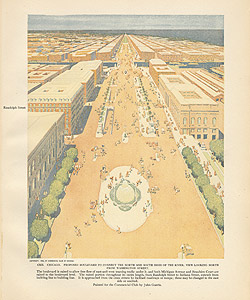|
|
A few playful catcalls greeted the architect Louis Sullivan last week at the Union League Club. Actually it was a photo of Sullivan flashed on a movie screen, a preview of an upcoming documentary by the Chicago filmmaker Judith McBrien about the architect and city planner Daniel Hudson Burnham. The movie, called Make No Little Plans, is slated to premiere next year in Millennium Park, part of a summer-long centennial salute to Burnham’s 1909 Plan of Chicago. You can see the film’s trailer here.
Though the Burnham Plan Centennial organization won’t officially announce its lineup of events and projects until June, a lively crowd of about 200 people got a sneak peak at the plans when they gathered in the Union League’s elegant sixth-floor dining room last week. Among the crowd were several Burnham descendants—which explains the good-natured boos and hisses directed at Sullivan, who famously denounced Chicago’s 1893 Columbian Exposition and its classical White City, which had risen under Burnham’s direction.
Leading the heckling was Shannon Burnham Kirby, Burnham’s great-granddaughter, a San Francisco interior designer who had traveled to Chicago by train with her sister, Mardi Brayton. The sisters came bearing gifts, two giant engraved silver loving cups presented to their illustrious ancestor by Chicago and San Francisco civic groups to honor Burnham’s ability as a city planner. The cups will remain at the Ryerson and Burnham Libraries at the Art Institute of Chicago for the next year.
Preparing for the centennial, Kirby and others have tracked down all 128 living descendants of Burnham—whom they all seem to refer to as DHB—and 27 of them were at the Union League Club. Most of them had never met one another before, so the evening had the festive atmosphere of a long-overdue family reunion. Surprisingly, many of them work in design professions—an idea that Burnham would have found congenial. In from Pittsburgh, Robert Pfaffman, an architect like his great-great-grandfather, discussed how his own interests were shifting. “I’ve become more passionate about city planning,” he said. “As you get older, you begin to realize the direct influence of Burnham on your own work.”
Family members had spent their spare time visiting the city’s various Burnham sites. Among other things, Kirby, who was born here, stopped by Graceland Cemetery to see the grave of her father and her great-grandfather. “The city is in our DNA,” said Kirby. “No matter where we live, Chicago is home.”
Illustration: © Chicago History Museum





